| |
 |
 |
 |
 |
-GURU
|
 |
Tonights demo is to illustrate a question I have answered several times. "What was used before sandpaper and modern tools to make smooth surfaces?"
|
 |
 |
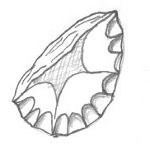
Figure 4 |
Scrapers date from the stone age and are some of the most commonly found stone tools. They were used to scrape flesh from hides, meat from bone, shape bone and wood. A very universal tool. The stone age pocket knife.
|
 |
 |

Figure 5 |
For over 200 years, up until the 1960's when labor became too expensive every precision surface on machine tools was hand scraped flat with a chisle shaped scraper.
It is common today to make them from old files. The length provides a good two handed grip.
Early precision flats were blued (prussian blue oil paint) and hand scraped flat before fine in honeing against each other in sets of three.
These in turn were used to check machine surfaces. Today some machine tool makers use a light scraping over ground surfaces to provide a better surface to hold oil. This is called a "flaked" surface.
|
 |
 |
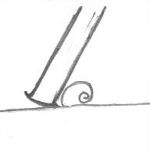
Figure 6 |
The most efficient scraper is a plain hard steel bar with a fine "hook" on the edge. This hook produces a fine curling chip like a plane. Plain scrapers of this sort have also been in use for hundreds of years. Today musical instrument makers use them more than any other craftspeople.
|
 |
 |
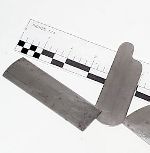
Figure 2 |
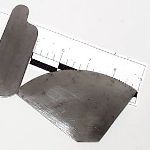
Figure 3 |
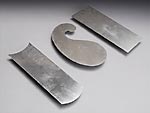
Luthiers Scrapers from Stewart-McDonald's Catalog |
 |
-GURU
|
 |
Scrapers are made from a spring hard piece of steel about 1/32" (1mm) to 1/16" (2mm) thick. The size and shape can vary. Commercial ones are 1.5" to 2" by about 4" (50mm x 200mm).
I made these from band saw blade and circular saw blade. If you use band saw blade be sure it is not the bi-metal type.
|
 |
 |
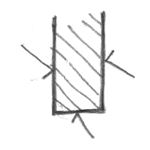
Figure 7 |
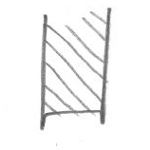
Figure 8 |
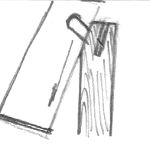
Figure 9 |
 |
-GURU
|
 |
The edge of the scraper is prepared by stoning the sides and edges to produce a crisp sharp square corner.
The smoother the edge, the smoother the cut.
After dressing, a wire edge is produced with a burnisher.
It is drawn along the edge as pressure is applied.
One or two firm strokes are all that is necessary.
NOTE: There is an error in figure 9, the burnisher should angle toward the direction it is pulled.
|
 |
 |
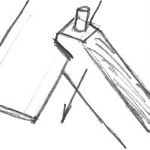
Figure 11 |

Figure 10 |
 |
 |
-GURU
|
 |
After drawing out a burr the burnisher is used to roll the hooked edge.
The burnisher pin should be oiled with a little light machine oil.
It can be pulled toward you OR pushed away (your preference).
Firm steady pressure is applied. One stroke should do it. Sometimes is takes more.
|
 |
 |
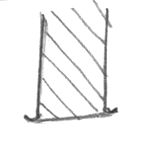
Figure 12 |
You can curl a "hook" on one or both edges.
I generaly put them on all 4 edges of rectangular scrapers and then work through them until the whole needs sharpening again.
|
 |
 |

Figure 13 |
Scrapers with a hook do what is called "micro planing".
In wood, plastic, brass, aluminium and soft (annealed) steel they will curl super fine chips as shown.
In fine wood working a scraped surface can be ready to finish.
|
 |
-GURU
|
 |
The scrapers shown above were made to hand fit an 8" (~200mm) diameter by 24" (~610mm) long babbit bearing that had a taper AND a curve to fit on a worn shaft.
|
 |
 |
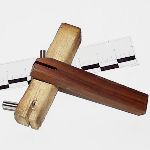
Figure 1 |
These burnishers are one I made (the ugly one) and a commercial one from Timberline Tool, Medanales, NM.
The part that does the work is a plain hard steel dowel.
The commercial one has a 5/16" (8mm) dowel and I used a 3/8" dowel.
Mine was made "on-the-job" so I didn't get a chance to finish it but it worked.
|
 |
 |
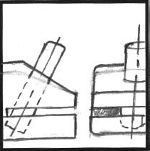
Figure 14 |

Figure 15 |
 |
 |
-GURU
|
 |
The tool is made from a piece of hard wood with a slot sawed in the end and a press fit hole drilled at a 15 degree angle to hold the dowel.
The commercial burnisher is 1" x 7/8" and mine is 1-1/8" x 1-1/8".
1" x 1" (25 x 25mm) would work fine.
|
 |
-GURU
|
 |
Questions or comments?
|
 |
peter Fels
|
 |
Good Guru, is this done annealed or already hardened?
|
 |
kiwi
|
 |
do you harden them before turning up the hook?
|
 |
-GURU
|
 |
Yes the scraper is hard to start with (before dressing with a stone). The saw blade material I used was used in the "as-found" condition. I cut the round blade with a grinder and kept the steel cooled as I ground off the teeth.
|
 |
-GURU
|
 |
Scrapers need to be a little softer than the burnisher. Dowel pins are around 64-65Rc. I have a fancy Swedish steel scraper that is too hard to easily put on a curl and a cheaper one that works much better. The bandsaw blade I used was heavy metal cutting type and is just barely soft enough to curl an edge.
|
 |
Steve C
|
 |
How do these work compared to a file?
|
 |
-GURU
|
 |
Steve, They cut as fast as anything less than a rasp and leave a very smooth surface (ready to polish).
The burnisher I purchased through Stewart-McDonald Guitar Makers Supply (address below).
It came with a wonderful set of instructions (better than above) that are worth the cost of the tool.
|
 |
Jim C.
|
 |
Would this be the type of scraper used to fit the old power hammer bearings?
|
 |
-GURU
|
 |
If you cast babbit bearings slightly undersized, YES this is what you use to "blue in" babbit bearings.
Curved scrapers (sometimes with a handle) are used to rough bearing surfaces longitudenaly.
Straight scrapers are used to do the hand fitting.
Alternating diagonal strokes through the journal produce a very flat surface.
Many old machinists handbooks explain the process as part of babbiting. THIS is the tool you use!
|
 |
Joe Rolfe
|
 |
Would the butt of a broken drill bit make a good burnisher pin?
|
 |
-GURU
|
 |
HSS Drill shanks are annealed. BUT taps are ALL hard and would work very well if you could get a long enough piece.
The drill shank could be hardened but HSS is tricky. Then it would have to be ground. . A 50 cent dowel pin is a better deal.
|
 |
Gilly
|
 |
Once again you never cease to amaze me Guru! Thanks for a great demo!!
|
 |
JERRY
|
 |
I like the burnisher you show, mine is like a steel for kitchen knives--have to use the vise and boards to get a good curl.
|
 |
|
 |
Does the dowel pin roll during use or should it be pinned?
|
 |
-GURU
|
 |
No, the dowel pin is fixed so it doesn't rotate. The drilled hole needs to be a slight press fit.
Only about .005" in hard wood. More and the wood will split.
|
 |
Ten
|
 |
And the wire edge is thrust onto the scraper?
|
 |
-GURU
|
 |
The wire edge is first pulled straight out then curled over in a "hook". In practice it is so fine that it is very hard to see. But it is REAL easy to find with your finger!
|
 |
Joe Rolfe
|
 |
I see scraper holders in my woodworking catalogues. Are they worth the money?
|
 |
-GURU
|
 |
Luthiers use those heavy duty paint scrapers for heavy scraping after regrinding the edge.
Otherwise I find the plain type works best hand held. I feel I get better control.
For some work you flex a curve into the blade to make it cut more or less.
You also use them at angles to the work that handles get in the way when using them.
|
 |
-GURU
|
 |
The great thing about this tool is the simplicity of using a plain dowel pin to do the work.
I seriously doubt that anyone buys a second one they are so easy to make.
When the pin wears or gets bits of steel stuck to it, you can rotate it with a pair of pliers.
If it gets too worn it is cheap to replace.
|
 |
Jim C.
|
 |
The wire edge is made by sharpening the scraper on a stone like sharpening a knife?
|
 |
-GURU
|
 |
The edge is ground and stoned as square as possible. The wire edge is produced with the burnisher.
|
 |
Joe Rolfe
|
 |
Jock; could you post a URL or address for the burnisher supplier with the great instructions?
|
 |
-GURU
|
 |
You can roll the curl with a plain burnisher (bar of hardened steel) IF you know how, but this little tool makes it a LOT easier.
Worked the first time for me! And the ugly home made burnisher worked too.
I bought the Timberline Tool Burnisher from:
Stewart-McDonald's Guitar Shop Supply
Box 900
Athens, OH 45701
800-848-2273
If you want to build guitars, harps or other stringed instruments these folks are great.
They carry many tools and odd supplies that are very hard to find.
|
 |

